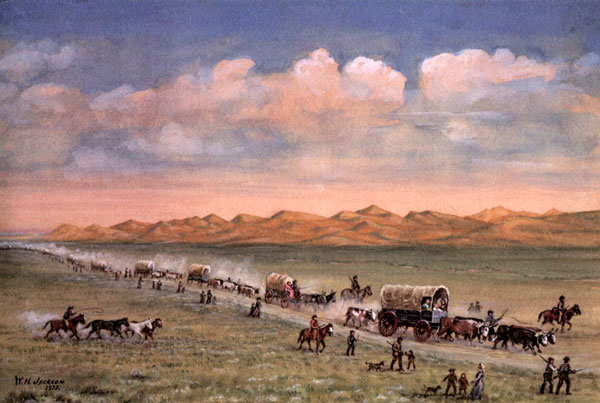Bagley, Will. So Rugged and Mountainous, University of Oklahoma Press, 2011.
Fifty years later, Catherine Sager Pringle recalled that her father was one of the “restless” ones who took his large family, including a pregnant wife, west along the Oregon Trail in 1844. A German immigrant, Henry Sager sold his property in the Platte Purchase and in April started across the plains with William Shaw’s train. There were six children in the family, four girls and two boys, hardly old enough to be of any help. On the North Platte, a wagon wheel crushed Catherine’s leg and all the Sager males fell dangerously ill.
One month later, along the Green River, Henry realized that he was dying and could not be reconciled to the thought of leaving his helpless wife and children alone. On August 28 he died and was buried on the banks of the river while his wife nursed her newborn. In September, Mrs. Sager fell ill and died just west of Fort Bridger, leaving her 4-month old newborn, Henrietta, and the other children orphans.
How could we not care about these people?
“So Rugged and Mountainous” is a monumental work, vast in scope, precise in detail, generous in vision; and Will Bagley, a professional historian not connected to any academic institution has drawn on a vast reservoir of primary sources—personal letters and journals, newspaper reports, government documents and folk accounts—to produce a new and lasting contribution to the continuing project known as New Western History.
Bagley ascends the heights climbed before him by such luminaries as Francis Parkman (who traveled the trail as far as Fort Laramie in the mid-19th century), the brilliant Bernard DeVoto, Wallace Stegner, David Lavender and the estimable Dale Morgan, yet manages to create a deeply indelible phenomenology of western migration that offers continuing insights into the migrants and their world.
Much like Patricia Limerick at the University of Colorado, who pioneered deconstructivist Western History, Bagley concentrates on both material culture and sociology, which never neglecting the wider historical context.
One would think that the narrative has been all but mined dry. But Bagley digs deeply into the trail itself and discovers it in ways that are new, rich, exciting and different—its geographical and topographical facts, the social and political structure of its travelers, the day-to-day of travel. he describes in detail the construction of the wagons and handcarts involved, the care and feeding of animals (oxen had to be shoed—a shallow trough was dug, the animal tipped over into it, and men shoed the ox while its feet were helplessly in the air), the food and clothing, the weather, religion, breaking and making camp, health carte and food, among many other fascinating topics.
Wagon trains were societies in miniature. Trains, which differed in size nevertheless reflected the convictions, passions and beliefs of Americans in general—and reflected too their racial prejudices, religious passions and complicated mixtures of kinship, blood and marriage. Everybody went west and they went with every conceivable motive. Preachers went with their Bibles, lawyers with their books and doctors with their medicine chests. men ran from the law an their wives, nurserymen went with their trees, blacksmiths with their anvils and shoemakers with their awls, needles, bristles and lasts. Bagley takes it all in, including the reactions and many-layered responses of native Americans to the immigrants.
Contrary to popular imagination, the Oregon and California trails carried relatively few people (seldom much more than 1,500 people each year), far fewer than went b y boat around the Cape horn, for example. No matter, the westward migration stands with World War II as one of America’s proudest tims. And in many ways, Bagley’s project resembles most closely the writing of the great French historian Fernand Braudel, whose work on Mediterranean culture was equally comprehensive, yet exciting and readable.
“So Rugged and Mountainous” has been announced as Volume 1 of “Overland West: The Story of the Oregon and California Trails.” Volume 2, titled “With Visions Bright Before Them” is next, with two subsequent volumes following at one-year intervals. Bagley is shaping up not only to write history, but to make it.


